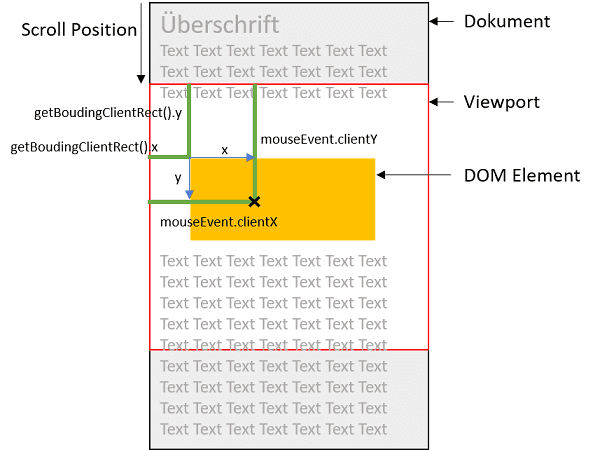Canvas Interaktion und Animation (1/3)
Punkte malen
Dieses erste Beispiel zeigt, wie man mit dem Canvas über Mausklicks interagieren kann.
Zur Berechnung der Position des Mausklicks im Canvas DOM-Element, wird die Position innerhalb
des Viewports (= Anzeigebereich)
für den Mausklicks über das MouseEvent
und für das DOM-Element über getBoundingClientRect
herangezogen.
HTML<canvas id="myCanvas" width="400" height="400"></canvas>
CSS#myCanvas {
border: 1px solid;
}
JavaScriptconst canvas = document.getElementById('myCanvas');
const ctx = canvas.getContext('2d');
canvas.addEventListener('click', onClick);
function onClick(evt) {
const canvasClientRect = canvas.getBoundingClientRect();
const x = evt.clientX - canvasClientRect.x;
const y = evt.clientY - canvasClientRect.y;
// draw black dot
ctx.beginPath();
ctx.arc(x, y, 10, 0, 2 * Math.PI);
ctx.fill();
}
Punkte animieren
Dieses Beispiel führt eine Animation der gemalten Punkte ein.
Dazu wird die Window-Funktion requestAnimationFrame verwendet,
die den Aufruf einer gegebenen Funktion vor der nächsten Bildschirmaktualisierung anfordert.
JavaScriptconst canvas = document.getElementById('myCanvas');
const ctx = canvas.getContext('2d');
// physics animation parameters
const dotAcceleration = -2000; // pixel per second^2
const bouncingLossFactor = 0.9; // speed loss factor when rebouncing at the bottom
const minBouncingSpeed = 25; // minimum speed stopping
// physics animation state
let dotX = window.innerWidth / 2;
let dotHeight = 0; // pixel above bottom
let dotSpeed = 0; // pixel per second
let animationTime = null; // current animation time
canvas.addEventListener('click', onClick);
function onClick(evt) {
const canvasClientRect = canvas.getBoundingClientRect();
const x = evt.clientX - canvasClientRect.x;
const y = evt.clientY - canvasClientRect.y;
// initialise animation
dotX = x;
dotHeight = canvas.height - y;
dotSpeed = 0;
// start animation
animationTime = 0.001 * performance.now();
requestAnimationFrame(onAnimationFrame);
}
function onAnimationFrame() {
const now = 0.001 * performance.now();
const deltaTime = now - animationTime;
if (animateDot(deltaTime)) {
// clear canvas
ctx.clearRect(0, 0, canvas.width, canvas.height);
// draw dot
let dotRadius = 10;
ctx.beginPath();
ctx.arc(dotX, canvas.height - dotHeight, dotRadius, 0, 2*Math.PI);
ctx.fill();
// advance animation time
animationTime = now;
// continue animation
requestAnimationFrame(onAnimationFrame);
}
}
function animateDot(deltaTime) {
// update height from speed
dotHeight += deltaTime * dotSpeed;
// bounce at bottom
if (dotHeight <= 0) {
dotHeight = -dotHeight; // correct of negative y-positions
dotSpeed *= -bouncingLossFactor; // invert speed and apply loss
// stop animation when rebouncing too slowly
if (dotSpeed < minBouncingSpeed) {
return false;
}
}
// update speed from acceleration
dotSpeed += deltaTime * dotAcceleration;
// continue animation
return true;
}
Dieses Beispiel zeigt eindrücklich die Grenzen eines Programms, das den Zustand eines interaktiven und/oder animierten Objekts - hier ein Punkt - mit einer Reihe von einfachen Variablen implementiert, mit denen lediglich der Zustand eines einzigen Objekts dargestellt werden kann.
Um den Zustand mehrerer Objekte - mehrerer Punkte - abzubilden, bietet sich die Verwendung von JavaScript-Objekten an.
